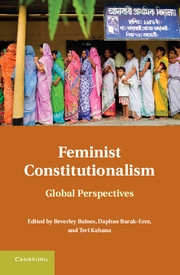Book contents
- Frontmatter
- Contents
- Foreword
- Contributors
- Introduction
- Part I Feminism as a Challenge to Constitutional Theory
- Part II Feminism and Judging
- Part III Feminism, Democracy, and Political Participation
- 9 The Gendered State and Women's Political Leadership
- 10 On Parity, Interdependence, and Women's Democracy
- 11 Women's Involvement in International Constitution-Making
- 12 Between Constitutional Jurisdiction and Women's Rights Organizations
- 13 The Promise of Democratic Constitutionalism
- Part IV The Constitutionalism of Reproductive Rights
- Part V Women's Rights, Multiculturalism, and Diversity
- Part VI Women between Secularism and Religion
- Index
- References
10 - On Parity, Interdependence, and Women's Democracy
Published online by Cambridge University Press: 05 June 2012
- Frontmatter
- Contents
- Foreword
- Contributors
- Introduction
- Part I Feminism as a Challenge to Constitutional Theory
- Part II Feminism and Judging
- Part III Feminism, Democracy, and Political Participation
- 9 The Gendered State and Women's Political Leadership
- 10 On Parity, Interdependence, and Women's Democracy
- 11 Women's Involvement in International Constitution-Making
- 12 Between Constitutional Jurisdiction and Women's Rights Organizations
- 13 The Promise of Democratic Constitutionalism
- Part IV The Constitutionalism of Reproductive Rights
- Part V Women's Rights, Multiculturalism, and Diversity
- Part VI Women between Secularism and Religion
- Index
- References
Summary
Women's low presence in political representative bodies has become a common concern in present-day democracies. It raises doubts as to how effectively democracies are capable of implementing women's political rights on an equal footing with men's and arouses concerns about women's substantive equality with men more generally. Furthermore, women's low presence in political representative bodies raises questions as to women's status as citizens, and consequently as to the state of health of citizenship in democratic systems. At the same time, however, legal measures designed to increase women's presence in representative bodies are problematic both from the perspective of rights and equality and from the perspective of citizenship in representative democracies. Some of these measures, and those that we will focus on, consist of legally sanctioned representation quotas for women or of legally sanctioned gender parity in representative bodies. Both raise a variety of constitutional issues. These issues can be confronted as issues of constitutional rights or as issues of citizenship and democratic representation. Most often, constitutional reasoning regarding legally sanctioned quotas or parity in political representation has centered on a debate focusing on the right to equality, about whether the political sphere allows for substantive equality and, if so, what implications this has. Questions concerning the right to vote and stand for elections have also been raised in connection with equality, as have questions concerning the autonomy of political parties. Parallel to this situation, legally sanctioned quotas or parity in political representation have also raised questions from the perspective of citizenship and democratic theory, notably whether they are inconsistent or compatible with, or actually required by, the constitutionally sanctioned system of general and unitary representation that underlies political representation in modern states.
In this chapter we examine the range of possible constitutional approaches to legally imposed gender parity and gender electoral quotas and analyze their constitutional implications. We first discuss the rights perspective approaches, to argue then that the proper discussion should be much more about the requirements of citizenship in a representative democracy. We will analyze these discussions relying on some of the most recent cases brought concerning such types of measures in several countries, including France, Italy, Switzerland, Colombia and, most recently, Spain. Finally, we take the position and defend that gender political quotas can best be justified under a distinct parity democracy model.
- Type
- Chapter
- Information
- Feminist ConstitutionalismGlobal Perspectives, pp. 188 - 203Publisher: Cambridge University PressPrint publication year: 2012
References
- 2
- Cited by

